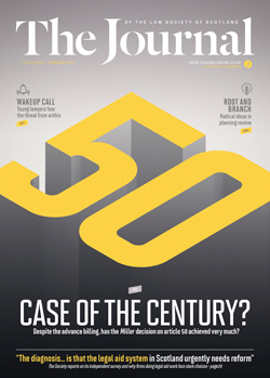Contact and the fear factor

Two recent decisions bring into sharp focus the extent to which one parent’s views and attitude may play a determinative role in the other parent’s role and relationship with their child post-separation.
J v M [2016] CSIH 52 was an appeal to the Inner House from a sheriff court decision. There were high levels of conflict between the parties and their respective families following allegations of sexual abuse towards the child. The mother believed the father had sexually abused the child and was vehement in her opposition to contact. The father accused the mother and her family of coaching the child to make false disclosures. The sheriff refused to order contact, a decision upheld by the Inner House.
Why have two cases which, on the face of it, deal with similar issues of conflict between parties, reached different decisions on the issue of contact, particularly when in AH v CH the child expressed the view that he did not want contact with his father, while in J v M the child’s views were not a factor (presumably due to the child’s age)? While every case in relation to children turns largely on its own facts, there are a number of contrasting factors which might shed some light on other similar situations.
Distinguishing features
First, the courts took differing views on the reasons given for the mothers’ respective attitudes to contact. In AH v CH, the mother held a genuine fear that the child was going to be abducted. She did not trust the child’s father and, despite the steps the court could take to allay her fears, she remained unconvinced. Lord Brailsford considered that, against the background of deceit by the father, the mother’s fear of abduction, even if objectively irrational, was genuinely held.
In comparison, the mother’s belief in J v M that the father had sexually abused the child, despite the father never being charged with an offence nor any reference being made to a children’s hearing, was supported by a finding in fact that there were “reasonable grounds to suspect… some aspect of sexual abuse”, and that the allegation of abuse therefore “provided a sound basis for a prediction of deep ongoing hostility”. Whilst the appeal court considered that “a parent should not be given a veto over contact”, it noted that: “The present is not a case of a parent who, with no reasonable basis, implacably opposes contact, and sets out to frustrate the court’s orders.
On the contrary there is, as the sheriff carefully explained, a foundation for the defender’s and her family’s hostility to the whole idea. It is not a ploy or pretext for shutting out the pursuer. It is hostility based on strongly held beliefs.”
Secondly, there were differing degrees of conflict at play. In AH v CH, the conflict was restricted to that between the parties.
In J v M, there were widespread strong feelings of dislike towards each party and their respective families, with the sheriff describing the atmosphere between the parties and their families as “appalling”. The mother and her family would require to play a part in the operation of contact. The sheriff considered that was not a situation that the child would be able to cope with.
Thirdly, in AH v CH Lord Brailsford had the benefit of independent expert evidence on the options for the child in relation to contact with his father and understanding the risks associated with those options. His Lordship placed particular emphasis on the significant disadvantages to the child if he were not to have contact with both parents, which were identified by the expert. He would more likely experience difficulties academically, psychologically, emotionally and in future relationships in later life.
It is notable that Lord Brailsford placed particular emphasis on the long-term effect on the child if there was no contact, noting: “I have to weigh the potential for adverse effects in later life against a child’s currently expressed opinion against contact, always bearing in mind that that expression of view has been engendered by his mother’s attitude and that when he actually experiences contact he enjoys meeting his father.” In comparison, there does not appear to have been expert evidence before the court in J v M, and while the Inner House made clear that the court “has a responsibility to respect and promote family relationships”, there was not, before the court, any evidence as to the “long and medium-term psycho-social disadvantages” of denying a child contact with one parent.
Send for an expert?
The weight placed on the expert evidence before the court in AH v CH runs against the general trend of recent decisions (for example, Sheriff Anwar’s decision in Q v P 2016 Fam LR 54) that it is not necessary to have experts in straightforward child cases, and might therefore give practitioners further pause for thought as to whether an expert instruction is appropriate in cases of extreme conflict or where one party seeks to oppose all contact with the child by the other.
There is one school of thought that in extreme cases the behaviour of one party brings out “parental alienation syndrome”, where children have taken on the views and attitudes of one parent against the other. This, in turn, ruins the relationship with the other parent. There is considerable debate in academic circles over whether an identifiable syndrome exists. AH v CH has been heralded in some quarters as being a further step towards the courts acknowledging its existence, albeit this phrase is not mentioned anywhere in the judgment.
The overarching principle set out in s 11(7) of the Children (Scotland) Act 1995 provides that the welfare of the child is the paramount consideration. In considering the welfare of the child, a court’s decision can turn on subtle factors. One instance could be the weight attached to any views of one parent negatively influencing the child’s relationship with the other parent, which was an acknowledged feature of AH v CH. In particular, the provisions in s 11(7B)-(7D) arguably bring this subtle factor into even sharper focus. The court must have regard to “any abuse or the risk of any abuse” that might affect the child and any effect it may have. In terms of s 11(7C), abuse includes conduct giving rise, or likely to give rise, to physical or mental injury, fear, alarm or distress. In making any contact order (or any order in terms of s 11), the court, in terms of s 11(7D), has to consider, where in pursuance of the order two or more relevant persons would have to co-operate with one another as respects matters affecting the child, whether it would be appropriate to make the order.
Although these provisions are usually thought of in the context of abusive conduct by the estranged parent towards the parent principally caring for the child, parental conduct which influences a child’s relationship with the other parent, subconsciously or otherwise, could fall within the definition of “abuse”. The 1995 Act arguably already well equips the court, either via general application of the overarching paramountcy of the child’s welfare, or in terms of s 11(7B)-(7D), to consider such factors, without the necessity to recognise any behaviour as falling to be classed as a particular syndrome.
AH v CH and J v M provide recent examples of the court dealing with conflict of differing degrees between parties, and assist family law practitioners by providing an overview of the relevant principles and factors when determining what is in the best interests of the child. They also serve as a reminder that practitioners will have to give careful consideration as to the necessity for and remit of expert witnesses in cases where there is a high degree of conflict. We will all be alive to the parties’ behaviour not being something new to the issues in many contact disputes, and I suspect that many would agree with Lord Brailsford’s observation in AH v CH, referring to the stress on the child through feeling the need to please his mother:
“It is, regretfully, in my experience, a not uncommon feature of contact disputes, particularly those of an intractable nature. In my opinion the best, and possibly the only, way to address this lies in the hands of the parents. They have in my opinion an overriding duty to put aside any antipathy, distrust or resentment held towards a former spouse in order to ensure that their child is not exposed to the sort of risks identified”.
In this issue
- Miller, Brexit and BreUK-up
- Power to the people?
- Prerogatives, Parliament and the constitution: plus ça change?
- Decisions in high places
- Reading for pleasure
- Journal magazine index 2016
- Opinion: Callum Sinclair
- Book reviews
- Profile
- President's column
- Have you heard of ScotLIS?
- People on the move
- Article 50: the final say
- Where courts fear to tread
- "Wake up": how young lawyers see the future
- How healthy is our legal aid system?
- Challenging assumptions
- Planning to deliver
- Contact and the fear factor
- And the bill goes to...?
- Pakistan to join Child Abduction Convention
- Dress to impress?
- Handcuffing of prisoners and article 3
- Turning up the heat on workplace change
- Scottish Solicitors' Discipline Tribunal
- Not just for the green welly brigade
- Five by five
- Law reform roundup
- Relief over pensions and bankruptcy ruling
- Helpline plus
- Spill the beans on legal aid fraud
- The art of bringing the good news
- Cybercrime: how are you protected?
- Ask Ash
- One year rule becomes three
- From the Brussels office






